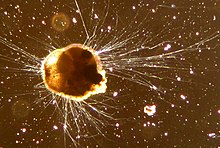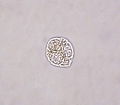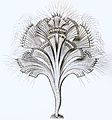| Revision as of 19:09, 14 November 2019 editAlex Cohn (talk | contribs)Extended confirmed users, Pending changes reviewers, Rollbackers16,563 editsm Reverted edits by 74.219.0.154 (talk) to last version by Peter coxheadTag: Rollback← Previous edit |
Revision as of 23:28, 12 December 2019 edit undo75.134.67.52 (talk) fixed gramatical errorsNext edit → |
| Line 15: |
Line 15: |
|
}} |
|
}} |
|
|
|
|
|
The '''Rhizaria''' are a species-rich supergroup of mostly ]<ref>{{cite web | url = http://www.palaeos.com/Eukarya/Units/Rhizaria/Rhizaria.html | year = 2004 | author = Christopher Taylor | title = Rhizaria | url-status = dead | archiveurl = https://web.archive.org/web/20090420034036/http://www.palaeos.com/Eukarya/Units/Rhizaria/Rhizaria.html | archivedate = 2009-04-20 }}</ref> ]s.<ref name="pmid15148395">{{cite journal |vauthors=Nikolaev SI, Berney C, Fahrni JF, etal |title=The twilight of Heliozoa and rise of Rhizaria, an emerging supergroup of amoeboid eukaryotes |journal=Proc. Natl. Acad. Sci. U.S.A. |volume=101 |issue=21 |pages=8066–71 |date=May 2004 |pmid=15148395 |pmc=419558 |doi=10.1073/pnas.0308602101 }}</ref> Except from the ] and three species in the genus ] in the phylum ], they are all non-photosyntethic, but many foraminifers have a symbiotic relationship with unicellular algae. A multicellular form, ''Guttulinopsis vulgaris'', a cellular ], has also been described.<ref>{{cite journal | url=http://www.cell.com/current-biology/abstract/S0960-9822(12)00413-7 | year = 2012 | author = Brown| title = Aggregative Multicellularity Evolved Independently in the Eukaryotic Supergroup Rhizaria |display-authors=etal | doi=10.1016/j.cub.2012.04.021 | volume=22 | issue = 12 | journal=Current Biology | pages=1123–1127 | pmid=22608512}}</ref> |
|
The '''Rhizaria''' are a species-rich supergroup of mostly ]<ref>{{cite web | url = http://www.palaeos.com/Eukarya/Units/Rhizaria/Rhizaria.html | year = 2004 | author = Christopher Taylor | title = Rhizaria | url-status = dead | archiveurl = https://web.archive.org/web/20090420034036/http://www.palaeos.com/Eukarya/Units/Rhizaria/Rhizaria.html | archivedate = 2009-04-20 }}</ref> ]s.<ref name="pmid15148395">{{cite journal |vauthors=Nikolaev SI, Berney C, Fahrni JF, etal |title=The twilight of Heliozoa and rise of Rhizaria, an emerging supergroup of amoeboid eukaryotes |journal=Proc. Natl. Acad. Sci. U.S.A. |volume=101 |issue=21 |pages=8066–71 |date=May 2004 |pmid=15148395 |pmc=419558 |doi=10.1073/pnas.0308602101 }}</ref> Except from the ] and three species in the genus ] in the phylum ], they are all non-photosynthethic, but many foraminifers have a symbiotic relationship with unicellular algae. A multicellular form, ''Guttulinopsis vulgaris'', a cellular ], has also been described.<ref>{{cite journal | url=http://www.cell.com/current-biology/abstract/S0960-9822(12)00413-7 | year = 2012 | author = Brown| title = Aggregative Multicellularity Evolved Independently in the Eukaryotic Supergroup Rhizaria |display-authors=etal | doi=10.1016/j.cub.2012.04.021 | volume=22 | issue = 12 | journal=Current Biology | pages=1123–1127 | pmid=22608512}}</ref> |
|
This supergroup was proposed by ] in 2002. Being described mainly from ] sequences, they vary considerably in form, having no clear morphological distinctive characters (]), but for the most part they are ]s with filose, reticulose, or microtubule-supported ]s. Many produce shells or skeletons, which may be quite complex in structure, and these make up the vast majority of protozoan fossils. Nearly all have ] with tubular ]e. |
|
This supergroup was proposed by ] in 2002. Being described mainly from ] sequences, they vary considerably in form, having no clear morphological distinctive characters (]), but for the most part they are ]s with filose, reticulose, or microtubule-supported ]s. Many produce shells or skeletons, which may be quite complex in structure, and these make up the vast majority of protozoan fossils. Nearly all have ] with tubular ]e. |
|
|
|
|
| Line 26: |
Line 26: |
|
* ] – amoeboids with ]s, common as marine ] |
|
* ] – amoeboids with ]s, common as marine ] |
|
|
|
|
|
A few other groups may be included in the Cercozoa, but on some trees appear closer to the Foraminifera. These are the ] and ], parasites of plants and animals, respectively, and the peculiar amoeba '']''. The different groups of Rhizaria are considered close relatives based mainly on genetic similarities, and have been regarded as an extension of the Cercozoa. The name Rhizaria for the expanded group was introduced by ] in 2002,<ref>{{cite journal |
|
A few other groups may be included in the Cercozoa, but some trees appear closer to the Foraminifera. These are the ] and ], parasites of plants and animals, respectively, and the peculiar amoeba '']''. The different groups of Rhizaria are considered close relatives based mainly on genetic similarities, and have been regarded as an extension of the Cercozoa. The name Rhizaria for the expanded group was introduced by ] in 2002,<ref>{{cite journal |
|
| first = Thomas |
|
| first = Thomas |
|
| last = Cavalier-Smith |
|
| last = Cavalier-Smith |
|
| authorlink = Thomas Cavalier-Smith |
|
| author link = Thomas Cavalier-Smith |
|
| title = The phagotrophic origin of eukaryotes and phylogenetic classification of Protozoa |
|
| title = The phagotrophic origin of eukaryotes and phylogenetic classification of Protozoa |
|
| journal = International Journal of Systematic and Evolutionary Microbiology |
|
| journal = International Journal of Systematic and Evolutionary Microbiology |
|
| year = 2002 | volume = 52 | issue = 2 | pages = 297–354 |
|
| year = 2002 | volume = 52 | issue = 2 | pages = 297–354 |
|
| issn = 1466-5026 |
|
| ISSN = 1466-5026 |
|
| url = http://ijs.sgmjournals.org/cgi/content/abstract/52/2/297 |
|
| URL = http://ijs.sgmjournals.org/cgi/content/abstract/52/2/297 |
|
| accessdate = 2007-06-08 |
|
| access date = 2007-06-08 |
|
| pmid = 11931142 |
|
| paid = 11931142 |
|
| doi=10.1099/00207713-52-2-297 |
|
| doi=10.1099/00207713-52-2-297 |
|
}}</ref> who also included the ]s and ]. |
|
}}</ref> who also included the ]s and ]. |
| Line 146: |
Line 146: |
|
{{Taxonbar|from=Q855740}} |
|
{{Taxonbar|from=Q855740}} |
|
|
|
|
|
] |
|
] |
|
] |
|
] |
|
] |
|
] |
|
] |
|
] |
A few other groups may be included in the Cercozoa, but some trees appear closer to the Foraminifera. These are the Phytomyxea and Ascetosporea, parasites of plants and animals, respectively, and the peculiar amoeba Gromia. The different groups of Rhizaria are considered close relatives based mainly on genetic similarities, and have been regarded as an extension of the Cercozoa. The name Rhizaria for the expanded group was introduced by Cavalier-Smith in 2002, who also included the centrohelids and Apusozoa.
In 2019, the Cercozoa were recognized as a basal Rhizaria group, as sister of the Retaria.

 Cercomonas sp. (Cercozoa: Cercomonadida
Cercomonas sp. (Cercozoa: Cercomonadida
 Ebria sp. (Cercozoa: Ebridea)
Ebria sp. (Cercozoa: Ebridea)
 Rhipidodendron sp. (Cercozoa: Spongomonadea)
Rhipidodendron sp. (Cercozoa: Spongomonadea)
 Euglypha sp. (Cercozoa: Euglyphida)
Euglypha sp. (Cercozoa: Euglyphida)
 Phaeodarians (Cercozoa: Phaeodarea)
Phaeodarians (Cercozoa: Phaeodarea)
 Clathrulina elegans (Cercozoa: Granofilosea: Desmothoracida)
Clathrulina elegans (Cercozoa: Granofilosea: Desmothoracida)
 Chlorarachnion sp. (Cercozoa: (Chlorarachniophyta)
Chlorarachnion sp. (Cercozoa: (Chlorarachniophyta)
 Vampyrella sp. (Cercozoa: Vampyrellidae)
Vampyrella sp. (Cercozoa: Vampyrellidae)
 Gromia (Cercozoa: Gromiidea)
Gromia (Cercozoa: Gromiidea)
 Powdery scab (Cercozoa: Plasmodiophorida)
Powdery scab (Cercozoa: Plasmodiophorida)
 Foraminiferans (Retaria: Foraminifera)
Foraminiferans (Retaria: Foraminifera)
 Polycystines (Retaria: Radiolaria)
Polycystines (Retaria: Radiolaria)
 Acantharians (Retaria: Radiolaria)
Acantharians (Retaria: Radiolaria)